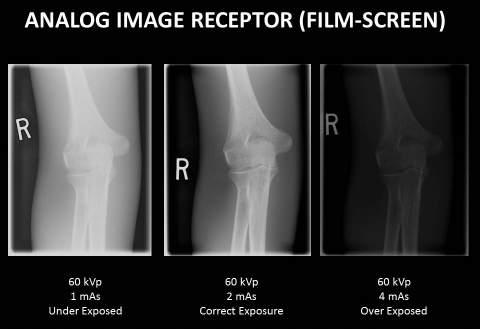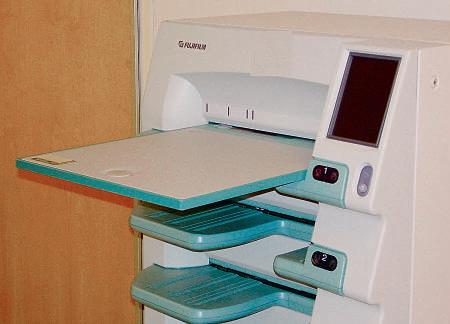
4 minute read
Digital imaging glossary
Algorithms: Highly complex mathematical formulas that are systematically applied to a data set for digital processing. Bit depth: Representative of the number of shades of gray that can be demonstrated by each pixel. Bit depth is determined by the manufacturer and is based on the imaging procedures for which the equipment is required. Brightness: The intensity of light that represents the individual pixels in the image on the monitor. Central ray (CR): The center point of the x-ray beam (point of least distortion of projected image). Charged couple device (CCD): A method of capturing visible light and converting it into an electrical signal for digital imaging systems. In radiography, a CCD device requires the use of a scintillator to convert the x-ray photons exiting the patient into visible light. CCD imaging systems are cassette-less in design. Contrast: The density difference on adjacent areas of a radiographic image. Contrast resolution: The ability of an imaging system to distinguish between similar tissues. Digital archive: A digital storage and image management system; in essence, a sophisticated computer system for storage of patient files and images. Display matrix: Series of “boxes” that give form to the image. Display pixel size: Pixel size of the monitor, related to the display matrix. Edge enhancement: The application of specific image processing that alters pixel values in the image to make the edges of structures appear more prominent compared with images with less or no edge enhancement. The spatial resolution of the image does not change when edge enhancement is applied. Equalization: The application of specific image processing that alters the pixel values across the image to present a more uniform image appearance. The pixel values representing low brightness are made brighter, and pixel values with high brightness are made to appear less bright. Exposure indicator: A numeric value that is representative of the exposure the image receptor received in digital radiography. Exposure latitude: Range of exposure intensities that will produce an acceptable image. Exposure level: A term used by certain equipment manufacturers to indicate exposure indicator. Flat Panel Detector with Thin Film Transistor (FPD-TFT): A method of acquiring radiographic images digitally. The FPD-TFT
DR receptor replaces the film-screen system. The FPD-TFT may be made with amorphous selenium or amorphous silicon with a scintillator. The FPD-TFT–based system may be cassette-based or cassette-less. Hard-copy radiograph: A film-based radiographic image. Hospital information system (HIS): Computer system, designed to support and integrate the operations of the entire hospital. Image plate (IP): With computed radiography, the image plate records the latent images, similar to the film in a film-screen cassette used in film-screen imaging systems. Noise: Random disturbance that obscures or reduces clarity. In a radiographic image, this translates into a grainy or mottled appearance of the image. Photostimulable phosphor (PSP) plate receptor: A method of acquiring radiographic images digitally. The main components of a PSP-based system include a photostimulable phosphor image plate, an image plate reader, and a workstation. The PSP-based system may be cassette-based or cassette-less. Pixel: Picture element; an individual component of the image matrix. Post-processing: Changing or enhancing the electronic image so that it can be viewed from a different perspective or its diagnostic quality can be improved. Radiology information system (RIS): A computer system that supports the operations of a radiology department. Typical functions include examination order processing, examination scheduling, patient registration, report archiving, film tracking, and billing. Smoothing: The application of specific image processing to reduce the display of noise in an image. Soft-copy radiograph: A radiographic image viewed on a computer monitor. Spatial resolution: The recorded sharpness of structures on the image; also may be called detail, sharpness, or definition. Unsharpness: Decreased sharpness or resolution on an image. Windowing: Adjustment of the window level and window width (image contrast and brightness) by the user. Window level: Controls the brightness of a digital image (within a certain range). Window width: Controls the range of gray levels of an image (the contrast). Workstation: A computer that serves as a digital post-processing station or an image review station.
Advertisement
RESOURCES (PART TWO) An exposure indicator for digital radiography. Report of AAPM Task
Group 116, July 2009, American Association of Physicists in
Medicine, College Park, MD. Baxes GA: Digital image processing, New York, 1994, John Wiley &
Sons. Carlton R, Adler AM: Principles of radiographic imaging: an art and a science, New York, 2005, Delmar Publishers. Dreyer KJ, Hirschorn DS, Mehta A, Thrall JH: PACS picture archiving and communication systems: a guide to the digital revolution, ed 2, New York, 2005, Springer-Verlag. Englebardt SP, Nelson R: Health care informatics: an interdisciplinary approach, St. Louis, 2002, Mosby. Huang HK: PACS: basic principles and applications, New Jersey, 2004, John Wiley & Sons. Papp J: Quality management in the imaging sciences, St. Louis, 2006, Mosby. Shepherd CT: Radiographic image production and manipulation,
New York, 2003, McGraw-Hill. Willis CE: 10 Fallacies about CR: decisions in imaging economics,
The Journal of Imaging Technology Management, December 2002. Available at www.imagingeconomics.com/issues/articles/ 2002-12_02.asp.










